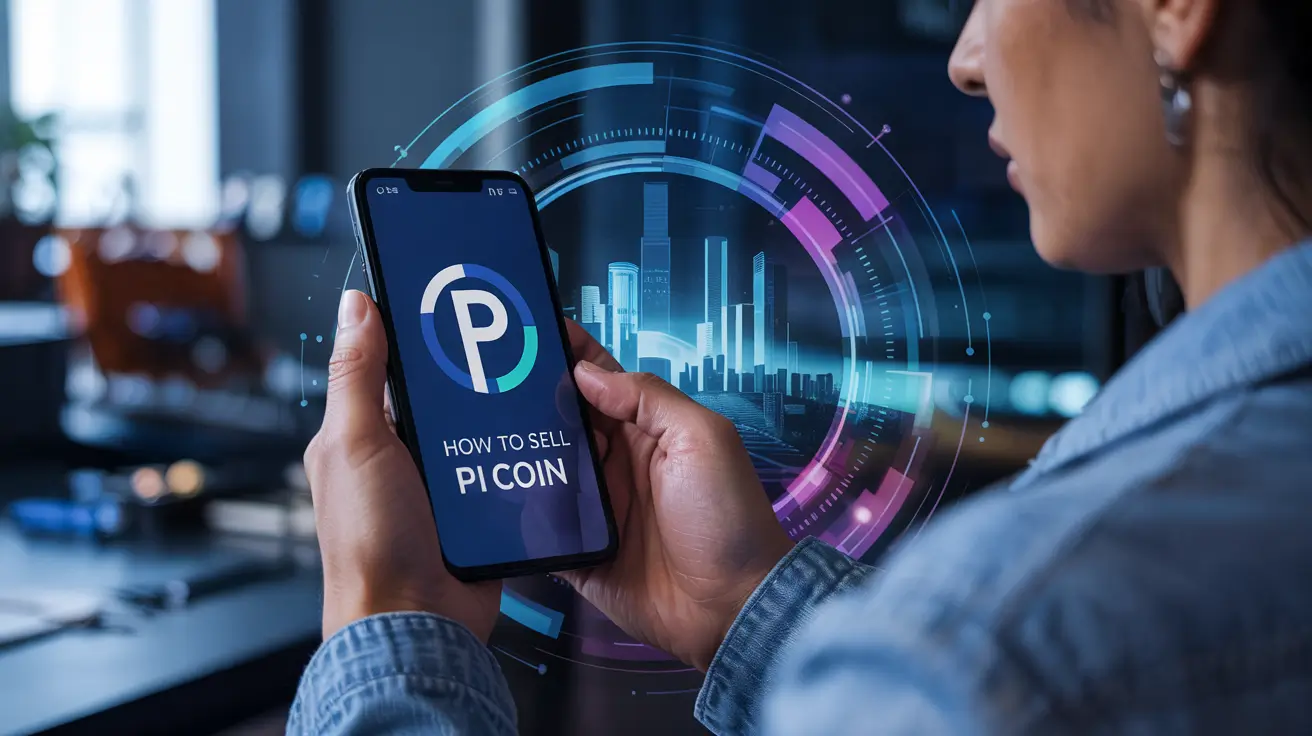Table of Contents
So, you’re a Pioneer. You’ve been consistently tapping that button on your Pi Network app, and the big question still lingers: How to Sell Pi Coin? You’ve seen the excitement, read the predictions, and probably stumbled across a lot of mixed information online. Let’s cut through the confusion—once and for all.
The Direct Answer (April 2025):
Yes, you can now sell Pi Coin—but not on major exchanges like Binance, Coinbase, or Kraken just yet. While those top-tier platforms haven’t listed Pi, the Open Mainnet officially launched on February 20, 2025, and Pi is now available for trading on a few select exchanges, including OKX, MEXC, and Bitget.
That means external transactions are finally possible, and the Pi Network is no longer in its Enclosed Mainnet phase. However, only Pioneers who’ve completed KYC and migrated their Pi to the Open Mainnet wallet can take advantage of this new opportunity.
This guide is your go-to resource for navigating this new phase of the Pi journey. Here’s what you’ll learn:
- Accurate Information: Why Pi is now partially tradeable, and what has changed since the Enclosed Mainnet days.
- Actionable Steps: How to complete your checklist, migrate your coins, and sell Pi safely on supported exchanges.
- Crucial Safety Warnings: Avoiding scams and unofficial channels that could put your Pi at risk.
- Future Possibilities: What to expect as Pi continues to grow and potentially lists on more exchanges.
We get it—the wait has been long, and the excitement is real. That’s why we’re here to give you a clear, updated roadmap to selling Pi Coin safely and smartly in 2025.
What is Pi Network & Why Isn’t Pi Coin on Every Exchange Yet?
Before diving into how to sell Pi Coin, let’s revisit the core of what Pi Network is—and why, even though the Open Mainnet is now live, Pi Coin still isn’t universally listed across major exchanges.
Pi Network launched with a bold mission: to create the world’s most inclusive and accessible cryptocurrency by empowering everyday users to mine coins directly from their smartphones. Unlike traditional crypto like Bitcoin, which requires expensive hardware and consumes large amounts of electricity, Pi Network uses a lightweight, eco-friendly consensus mechanism. This lets users (Pioneers) earn Pi simply by opening the app and validating their presence each day.

For years, the biggest barrier to trading Pi Coin was the Enclosed Mainnet phase. This phase was like having a fully built city—but surrounded by a high wall. The blockchain was functional, and Pioneers could transfer Pi among themselves, but it was cut off from the outside world. This is why Pi Coin wasn’t available for trading on platforms like Binance or Coinbase then.
What the Enclosed Mainnet Meant:
- Internal-Only Transfers: Pi was only transferable between KYC-verified users using the Pi Wallet within the Pi Browser.
- No Exchange Listings: A firewall blocked any external connection, meaning you couldn’t trade Pi Coin on real crypto markets.
- Focus on KYC & Ecosystem Growth:
- Mass KYC: Ensured only real people could earn and transfer Pi, protecting the network from bots.
- Utility Apps: Developers built DApps that used Pi Coin inside the ecosystem—adding real-world use cases.
- Infrastructure Testing: Allowed Pi Core Team to refine the network in a secure environment before going public.
The Big Shift: Pi’s Open Mainnet Is Now Live (2025)
On February 20, 2025, Pi Network finally transitioned to Open Mainnet. That means the firewall is down, and Pi is now externally accessible—select exchanges like OKX, MEXC, and Bitget have started listing Pi Coin for trading.
But don’t expect it to be everywhere just yet. Top-tier exchanges like Binance, Coinbase, and Kraken have not listed Pi Coin as of April 2025, largely due to ongoing compliance evaluations and volume requirements.
⚠️ Important: If your Pi is still in your in-app balance and hasn’t been migrated to your Mainnet wallet, it’s still locked in the closed environment. You’ll need to complete KYC and follow the migration process before you can trade.
TL;DR
Yes, you can now trade real Pi Coin—but only on specific exchanges and only if your Pi has been migrated to the Mainnet wallet. Any offer to buy or sell Pi Coin outside this process is likely a scam or an IOU (not backed by actual Pi). We’ll cover these risks and how to avoid them in a later section.
📌 Always refer to the official Pi Network Blog in the Pi Browser for verified updates on Mainnet phases and exchange listings.
The Path to Selling Pi Coin: How to Prepare for Open Mainnet (Updated for 2025)
Now that Pi Network’s Open Mainnet is live, you can sell Pi Coin on certain exchanges—but only if you’ve completed the Mainnet Checklist inside the Pi app.
⚠️ If your Pi hasn’t been migrated to your Mainnet Wallet yet, it’s still stuck in the in-app phase and cannot be traded. The steps below walk you through everything you need to do to finally unlock your Pi’s real-world value.
Step 1: Download the Pi Browser App
This is not the main mining app. The Pi Browser is a separate app that hosts key ecosystem features, including:
- Your Pi Wallet
- The KYC portal
- Mainnet DApps
👉 Download it from your device’s app store and log in using your Pi credentials.

Step 2: Create Your Pi Wallet
Launch the Pi Wallet DApp from within the Pi Browser.
- Create your Wallet: Follow the steps to generate your Mainnet wallet.
- CRITICAL – Secure your Passphrase:
- It’s your only way to access the wallet.
- Write it down and store it offline, in multiple secure places.
- Do not store it on cloud apps or digital notes.
- Never share it. If lost, your Pi is unrecoverable.
Step 3: Confirm Your Wallet Address
Go back to the Mainnet Checklist in the Pi app. You’ll need to link the wallet you created to your Pi account.
Double-check the wallet address before confirming—it’s where your migrated Pi will go.
Step 4: Set Up Lockup Configuration (Optional, But Strategic)
Users have the option to lock a portion of their Pi for a fixed duration, such as 6 months, 1 year, or 3 years.
- Why Lock Pi? Lockups increase your mining rate going forward.
- Selling Strategy Tip: Locked Pi cannot be transferred or sold until the lockup expires.
If you’re planning to sell right after migration, consider locking up only a portion or skipping this step entirely.
Step 5: Complete Your KYC (Know Your Customer) Verification
This is essential. Without KYC, you cannot migrate or trade Pi.
- Why KYC?
- Ensures every account belongs to a real human.
- Prevents abuse of the system (e.g., bots, multiple accounts).
- How it works:
- Use the KYC app in the Pi Browser to submit your ID and perform a liveness check.
- KYC slots may open gradually. Keep checking your Pi app for eligibility.
✅ Be patient. Many users experience delays or document verification issues. Follow instructions carefully and check official support if needed.
Step 6: Wait for KYC Approval
After you apply, your identity is reviewed by automated systems and human validators.
- Approval can take minutes to weeks.
- You’ll see the update in the Mainnet Checklist once it’s done.
Step 7: Migrate Your Pi to Mainnet
Once KYC is approved and other steps are complete:
- You’ll be invited to migrate your Pi.
- This includes your transferable balance (earned Pi + rewards – any locked amount).
- Agree to the migration conditions and wait for the pending process to complete.
Your Mainnet Pi will appear in your Pi Wallet—and that’s the balance you can use in DApps, transfer to others, or even sell on supporting exchanges.
Why This Checklist Matters Now More Than Ever
Completing the Mainnet Checklist is no longer about preparation—it’s about participation.
You now have the chance to own and trade real Pi on exchanges like MEXC, BitMart, HTX, and more, with wider adoption expected throughout 2025.
❗ Neglecting this process leaves your Pi in a “view-only” state—symbolic, but not usable.
How to Sell Pi Coin After Open Mainnet? (Speculative)
Disclaimer: The following scenarios are speculative. They’re based on how most cryptocurrencies become tradable after launching their open mainnet. The exact details and timing depend entirely on decisions made by the Pi Core Team and market conditions at the time.
Once the Open Mainnet firewall is lifted, and if Pi Network secures exchange listings, here are the most likely methods you might use to sell Pi Coin:
Scenario 1: Listing on Cryptocurrency Exchanges (CEXs & DEXs)
This is the most common route for mainstream crypto trading.
🔁 The Process:
The Pi Core Team would need to initiate partnerships with exchanges—both Centralized Exchanges (CEXs) like Binance, KuCoin, or Gate.io, and possibly Decentralized Exchanges (DEXs) if bridges are built with other blockchains.
Exchanges typically assess projects based on:
- Community size and activity
- Trading volume potential
- Blockchain technology and infrastructure
- Security protocols
- Regulatory compliance
💱 Where You’d Sell Pi Coin:
If listed, Pi Coin will appear on supported exchanges. Here’s how the process might look:
- Create an account on the exchange where Pi is listed (may require a separate KYC).
- Go to the “Deposit” tab and choose Pi Coin as your asset.
- The exchange will generate a unique deposit address for your Pi.
- Open your Pi Wallet inside the Pi Browser.
- Send the desired Pi amount to the exchange’s address.
- Be extremely careful: one wrong character can result in permanent loss of funds.
- Wait for network confirmation of the transaction.
- Once received in your exchange wallet, go to the “Trading” section (e.g., PI/USDT).
- Place a Sell Order—either at market price or a set limit.
- Once filled, you’ll receive the traded asset (e.g., USDT, BTC), which you can:
- Hold
- Trade for another asset
- Withdraw to a personal wallet or fiat
When exploring exchange-based options to sell Pi Coin, it’s essential to know which platforms support the Mainnet version. For a detailed breakdown of current and upcoming listings, check out our full guide: Where Can I Sell Pi Coin?
Scenario 2: Peer-to-Peer (P2P) Trading
P2P platforms enable direct trading between individuals, often with an escrow system to protect both parties.
🤝How It Works:
- Users list buy/sell offers with chosen payment methods (e.g., bank transfer, mobile wallets).
- When both sides agree, the seller places Pi in escrow.
- The buyer makes the payment and confirms.
- Once verified, the Pi is released from escrow into the buyer’s Pi Wallet.
🛠️ Where Could This Happen?
- Through third-party P2P platforms that add Pi Coin after the Open Mainnet
- Possibly within the Pi ecosystem itself if P2P tools are developed
- Dedicated Pi communities or apps (TBD by ecosystem growth)
⚠️ Considerations:
- Pros: More payment flexibility, no centralized intermediary
- Cons: Higher risk of fraud without secure platforms or dispute resolution
- Always use trusted platforms with strong escrow protections. Avoid unofficial, off-platform P2P trading, which exposes you to significant scam risks.
Understanding these potential routes reinforces why completing the Mainnet Checklist is crucial. Only verified users with migrated Pi balances will be able to interact with these future trading paths.
Pi Coin NOW: Read This Before You Try to Sell
🚨 WARNING: During the current Enclosed Mainnet phase, any platform or person claiming to let you sell Pi Coin for fiat (USD, EUR) or cryptocurrencies (BTC, ETH) is highly likely NOT dealing with real Pi.
Proceed with extreme caution.
The Truth About Pi IOU Tokens
You may notice “Pi Coin” listed on certain exchanges—such as Huobi or Bitmart in the past. But here’s the truth:
These are not real, transferable Pi Coins. They are IOUs (I Owe You tokens) or speculative futures contracts.
🔍 What Are Pi IOUs?
- IOUs represent a promise by the exchange to deliver actual Pi in the future—if they are able to acquire it post-Open Mainnet.
- They are not connected to your mined Pi in the official Pi Network app.
- You cannot deposit your real Pi Coin to trade them.
- You cannot withdraw these IOUs as real Pi.
⚠️ Extreme Risk Warning
- No Guarantee: Exchanges are not obligated to honor IOUs if they never receive real Pi.
- Delisting Risk: Exchanges can remove Pi IOUs without notice.
- No Wallet Support: You can’t interact with them using your actual Pi Wallet.
- Speculative Pricing: The price of these tokens has no basis in the actual value of Pi Coin—it’s pure speculation.
🔴 Bottom Line: You are NOT trading real Pi Coin. These IOUs are high-risk bets. Don’t confuse them with your actual Pi holdings.
Dangers of Unofficial P2P (Peer-to-Peer) Trades
In the Enclosed Mainnet stage, Pi is not meant to be exchanged for fiat or crypto. Any person trying to do so through unofficial P2P channels is putting your Pi at risk.
Common Scam Tactics:
- Advance Fee Fraud: “Send me money first, I’ll send Pi later” – they vanish after payment.
- Fake Escrow Sites: Look legitimate but are fully controlled by the scammer.
- Reversible Payments: Using PayPal “Friends & Family” to reverse the transaction after they get your Pi.
- Phishing Attempts: Asking for your wallet passphrase or Pi account credentials.
⚠️ Consequences:
- Violates Pi Network’s Terms of Service
- May lead to account suspension or wallet flagging
- There is no recourse if you get scammed
🚫 Never engage in unofficial P2P trades—especially ones found on social media, Telegram, or forums—until Pi Network officially endorses a secure method within its ecosystem.
Fake Websites & Malicious Apps
Scammers are now exploiting Pi’s popularity with fake sites and apps promising to:
- Instantly convert Pi to money
- Exchange Pi Coin with no KYC
- Offer “exclusive” tools to withdraw your Pi early
Their Real Goal?
- Steal your wallet passphrase
- Hack your Pi Network account
- Install malware on your device
✅ Only trust:
- The official Pi Network mobile app
- The official Pi Browser
- App downloads from Google Play Store or Apple App Store
Never enter your passphrase on a third-party site. Once compromised, your Pi is gone forever.
✅ Stay Safe, Stay Patient
Your mined Pi Coin has potential future value, but only if protected. Selling Pi now through unofficial or deceptive channels is one of the fastest ways to lose everything you’ve earned.
🛡️ Be skeptical. Be safe. Wait for the official Open Mainnet.
What’s the Real Pi Coin Price?
Many people are asking: “What is the Pi Coin value?” or searching “Pi Coin price now.”
As of April 2025, CoinMarketCap shows a listed Pi price (~$0.62), but this still doesn’t mean Pioneers can sell their Pi from the Pi app—it’s mostly IOU-based or wrapped versions. You can check the latest price on CoinMarketCap.
The “prices” seen on platforms like Huobi or Bitmart are typically for Pi IOU tokens, which are speculative placeholders, not real Pi. These prices are driven by speculation and do not reflect the actual value of the Pi you’ve mined within the Pi Network app.
What Will Determine Pi Coin’s Future Value?
When Open Mainnet launches and Pi becomes tradable on legitimate exchanges, several factors will likely influence its real-world value:
1. Utility in the Pi Ecosystem
The more dApps, games, marketplaces, and services are built around Pi—and accept it as payment—the more real-world demand it gains.
2. Community Strength
Pi’s large, global user base—especially when KYC-verified—makes it appealing to businesses, developers, and potential partners.
3. Successful Open Mainnet Launch
Ensuring a stable and safe move to Open Mainnet is essential for building confidence among users and investors.the
4. Exchange Listings
Only after listing on trusted, high-volume exchanges will users be able to buy/sell real Pi Coin, making the question “Where can I sell Pi Coin?” truly valid.
5. Overall Crypto Market Sentiment
If the broader market is bullish, Pi might launch with strong momentum. If bearish, adoption and price may take longer to mature.
6. Tokenomics
Factors such as the total circulating supply, distribution model, and burn mechanisms will affect Pi’s scarcity and value.
🔐 Until Open Mainnet, any current Pi Coin “price” is speculative. Focus on:
- Ecosystem development
- Completing your Mainnet Checklist
- Staying informed through official updates
When Will Pi Network Launch Open Mainnet?
This is the #1 question on every Pioneer’s mind:
“When can I sell Pi Coin?”
As of April 2025, the Pi Core Team has not confirmed an official launch date for the Open Mainnet. However, they’ve outlined three core conditions that must be met first:
1. Mass KYC Completion
A large percentage of the user base needs to be verified to maintain the network’s integrity and reduce bot activity. 2. Ecosystem Readiness
A diverse and functional app ecosystem within the Pi Browser must demonstrate real utility for Pi as a currency.
3. Favorable Market Conditions
Although somewhat subjective, the Core Team may be waiting for better global crypto market conditions before launching Pi into open trading.
How to Stay Updated (Avoid Scams & Fake News)
Ignore rumors on Telegram, Twitter, or YouTube claiming “Open Mainnet is live” or “Sell Pi now!”
Always check:
- 📱 Pi Network App → Check the Announcements tab
- 🌐 Official Website → https://minepi.com/
⚠️ Stay alert for scammers, phishing sites, and fake services that falsely claim they can help you “sell Pi” right now.
🧠 Remember:
The question is, “When can I sell Pi Coin?” It completely depends on the Open Mainnet rollout and official exchange listings.
Until then, focus on building, learning, and contributing to the ecosystem.
✅ Conclusion: How to Sell Pi Coin?
Selling your Pi Coin is not yet possible, but preparation is everything. As we step through April 2025, your best strategy is to:
- Complete the Mainnet Checklist fully and accurately
- Ignore all scams and fake trading platforms
- Stay in sync with official Pi Network updates only
- Focus on long-term utility, not short-term hype
Your patience and diligence now can pay off later—when the Open Mainnet launches and Pi becomes tradable on real exchanges. Don’t let frustration or FOMO lead you into risky territory. Stick to the plan, protect your assets, and get ready for the next chapter of Pi.
📌 Bookmark this page and subscribe to our newsletter (if available) to get notified when the Open Mainnet finally goes live and selling becomes possible.
Frequently Asked Questions (FAQ)
What is the official Pi Coin price in April 2025?
As of April 18, 2025, Pi Coin (PI) is trading at around $0.61, but this price reflects speculative IOU tokens or limited exchange availability and may not represent the fully launched Mainnet coin. Always verify with official Pi Network sources before making decisions.
When will Pi Coin be listed on Binance or Coinbase?
As of April 2025, Pi Coin is not listed on Binance, Coinbase, Kraken, or any major exchange. The Core Team has not announced any official partnerships with CEXs or DEXs. Listings will likely occur after Open Mainnet goes live.
How do I prepare to sell Pi Coin when it’s possible?
You must complete the Mainnet Checklist, which includes:
– Creating and securing your Pi Wallet
– Completing KYC verification
– Confirming your account and balance
– Choosing a lockup configuration
– Successfully migrating to Mainnet
Only users who complete this checklist will be eligible to transact Pi on the future open network.
Is Pi Network a scam or legit?
Pi Network is a real crypto project aiming to provide accessible mining and decentralized apps. It’s free to use and has never asked users for money to mine. However, it has faced criticism for delayed timelines and a lack of clarity. Be cautious of scams using Pi’s name—the official project operates through the Pi app and Pi Browser only.
Why is my Pi Coin locked?
During the migration process, users choose a voluntary lockup period to support network stability.





